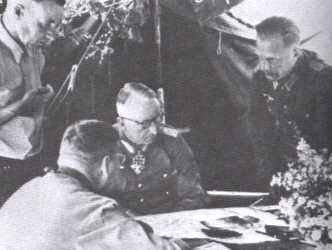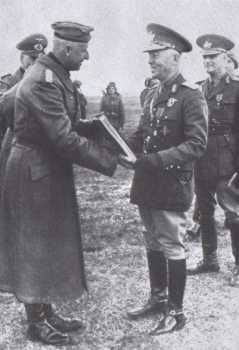
In the autumn of 1942, Eleventh Army was charged with the conquest of the Krim (in English: Crimea) peninsula, as the thread from the flank of Army Group South would threaten the flanks of further German advancement into Russia. In addition, Hitler wanted to send his forces through the Kerch straights into the Kuban for further operations, with the goal of eventually conquering the Caucasus. The following is a brief summary of this campaign.
The new commander of 11th Army, General der Infantery Erich von Manstein, took over his position on the 17th of September, 1941, after its former commander, Colonel-General Ritter von Schobert, was killed when his plane landed in a Russian minefield. Initially, the Army was tasked with invading the Crimea and the pursuit to Rostov, but it soon became apparent that the task of conquering the Crimea was to demand the full attention of the staff, and after the battle for of the Sea of Azov command was restructured and the Crimea became Eleventh Army's sole domain.
The Army order of battle included two Corps; 30 Corps, compromised of the 22nd, 72nd, and 170th Infantry Divisions and 54 Corps, compromised of 46th, 73rd, and 50th Infantry Divisions. The last mentioned Corps had already been in battle in the area, opening the first gateway to the Crimea in mid-September through a series of battles at Prerkop. Initially, the Army was to also be reinforced with 42 Corp Headquarters and 132nd and 24th Infantry Divisions. Also in their roster were parts of the 3rd Rumanian Army, which were supposed to be there mainly to perform coastal defenses. Eventually more Rumanian troops would join the campaign and take part in limited offenses.
The assault, which had to go through the narrow and barren Isthmus area, began on October 18th, 1941. This battle proved to be a most difficult challenge to the attackers, as the terrain was barren, and the Russian Air force continuously harassed the advancing forces. In addition, the narrowness of the gateway did not allow room for strategic manipulation, and most of the attacks were forcibly frontal. A furious ten day conflict followed, where the 3 divisions committed to battle (73rd, 46th and 22nd), encountered determined Russian resistance. It was only due to the aggressive fighting spirit of the German fighting troops that the disadvantages of the terrain and the enemy numerical superiority were overcome, and on October 28th the Soviet defense collapsed and the door to the Crimea was opened.
Eleventh Army now took full pursuit of the enemy entering the Crimea with all available forces. Thought weakened by heavy losses, the Divisions of both Corps gave the enemy furious pursuit, under General von Manstein's watchful eye. Of the 200,000 men committed to battle by the Soviets, 100,000 were captured along with 700 guns and 160 tanks. By the 16th of November all of the Crimea except for the fortress of Sevastopol was in German hands. Because of supply problems, the attack on the fortress could not begin until the 17th of December. This first attempt to penetrate the defenses would prove abortive in the end, due not only to the stiff resistance offered by the Soviets, who still enjoyed a numerical superiority (they had reinforced by sea), but also due to the beginning of the “Stalin Offensive”.
 |
|
The breakthrough at Isthmus and advance into Crimea |
The Soviet landings on the Kerch Peninsula on December 26th were more than a diversionary measure. They were an all out (and highly publicized) attempt to regain the initiative in the Crimea and wipe 11th Army off the map. To further complicate matters, it came at the critical moment when the bulk of the Army’s resources were tied up at Sevastopol. The only available troops in the Kerch peninsula were the 46th Infantry division, commanded by Count Sponeck, and a regiment of Rumanian mountain troops. The German Division was forced to conduct a fighting but desperate retreat, losing most of their heavy equipment in the process, while the Rumanian force could only muster a hasty retreat offering little opposition. The Red advance reached the Fediosa line before it could be stopped. A long series of attacks and counterattacks followed, with the last Soviet push coming on April 9th, 1942, when six divisions and 160 tanks attacked with the objective of driving the Germans out of Crimea. It would prove a complete failure, and by the 11th the attack was repelled.
Eleventh Army then conducted a major counterattack of its own, code named "Operation Bustard", aimed to finally expel the Russians from the Kerch area. The Kerch peninsula was defended by no less that 26 Soviet formations, of which 17 were rifle divisions, three rifle brigades, two Calvary divisions and four independent brigades. Against this force the Eleventh Army could counter with five infantry divisions of 30 Corp and the 22nd Panzer Division. Seventh Rumanian Corp compromised of 19 and 10 Rumanian Division, and 8 Rumanian Calvary Brigade complemented the German forces. On May 8th the battle jumped off, and by May 18th it was over, with a resounding German victory. After breaking through the lines, the Panzer Division gave the enemy a relentless pursuit that did not end until all Soviet forces had been captured. In all, the Germans captured 170,000 prisoners, 1,133 guns and 258 tanks. Five German Infantry Divisions and one Armored Division had annihilated two Soviet Armies.
Von Manstein's final goal was now to eliminate the only Soviet foothold in the Crimea, the heavily defended port fortress of Sevastopol. This was no easy task, as some of the fortress’s defenses dated back to the days before the Crimean War of 1854-6, but these were intermixed with modern, concrete strong points. It also counted with numerous defense lines belted around the city, heavily entrenched in favorable mountainous terrain. Finally, there were heavy coastal artillery batteries on the shores. Most of the troops available to Eleventh Army were used for this operation. The only Germans left to guard the Kerch peninsula and the south coast of the Crimea were 42 Corps Headquarters counting on the 46th Infantry Division. The German forces were supplemented by 7th Rumanian Corp, counting with the 10th and 19th Rumanian infantry divisions, 4th mountain division and 8th Calvary brigade.
The main thrust of the attack on Sevastopol, to come from the north/north east, was to be carried out by 54 Corps compromised of Infantry Divisions 22 (commanded by General Wolff), 24 (General Baron v. Tettau), 50 (General Schimidt) and 132 (General Lendemann). The attack in the south was to be carried out by 30 Corps, with 72nd and 170th Infantry Divisions and 28th Light Division under command. In the center, the Rumanian Mountain Corps was to pin down the enemy and protect the flanks of the charging German formations.

The attack was to be supported by 30 Corps artillery commanded by General Martinek, and 8th Air Corps commanded by General von Richthofen. The artillery available was certainly fabulous. Rail guns and heavy artillery were collected from all corners of the Reich to form the biggest artillery barrage up to that point. 54 Corps, who was to bear the brunt of the attack, counted on a total of 121 batteries supported by two observation battalions, as well as the heavy siege artillery. Among this heavy artillery was the much celebrated railway gun “Big Dora”, which had a caliber of 80cm and a barrel that was 90ft long. It required a crew or 500 men to fire, and 2,000 had to gather to assemble it, taking 6 weeks. Overall, the attacking forces had 208 batteries (not including AA) concentrated over a 22 mile front.
On the morning of June 7th, the furious barrage began, and all of the resources of the Luftwaffe descended on their targets with a murderous force. Shortly thereafter, the infantry battle began. The Russian defenders put a bitter defense spurt on by fanatical political commissars, very often fighting until the last man and the last round. The bitter resistance was only overcome by the courage and heroic determination of the German infantry soldier, who through his sacrifice and solid fighting spirit continued to advance in spite of all that was thrown against him. To make matters worse, temperatures reached upwards of 106 degrees, even in the morning.
| Rumanian troops, though often led by Officers holding on to antiquated
methods, did their duty as best they could. Because of their lack of
leadership, they were often placed under German command. Even so, when
suffering casualties of any significant degree, they were no longer
capable of offensive action and were limited to defensive and custodial
duty on quiet sections of the front. Marshal Antonescu, the Rumanian
leader, exercised a great of deal of positive influence upon his troops
and was held on very high regard by General von Manstein. To the right, we can see the two men meeting in the Crimea.
On the 13th of June, the 16th Infantry Regiment of the 22nd Division commanded by Colonel von Choltiz took one of the heaviest ramparts, Fort Stalin. One enemy defense ring after another fell to the advancing troops, though only through heavy fighting for every pillbox and machine gun nest. Eleventh Army found itself on the outer ring of the city on June 16th, though this by no means marked the end of the battle, as the Soviets were ready to resist within the city. This was adverted only by a bold move ordered by von Manstein, who directed an amphibious assault through Severnaya Bay on the night of the 28th-29th of June. This unhinged the fortification ring, and the final assault was a success. Though decided, the battle went on until July 4th, when 30,000 Soviets surrendered. In all, over 90,000 men of the Red Army were taken prisoner. |
 |
On July first, with triumphant fanfare, a message was sent out from Hitler’s headquarters. It read as follows;
To the Commander in Chief of the Crimean Army
Colonel General von MansteinIn grateful appreciation of your exceptionally meritorious services in the victorious battles of the Crimea, culminating in the fortress of Sevastopol, I hereby promote you to Field Marshal. By your promotion and the creation of a commemorative shield to be worn my all ranks who took part in the Crimean campaign, I pay tribute before the whole German people to the heroic achievements of the troops fighting under your command.
Adolf Hitler
![]()
© Copyright Wehrmacht-Awards.com LLC |